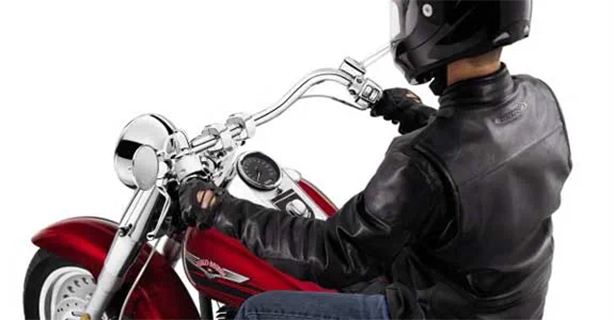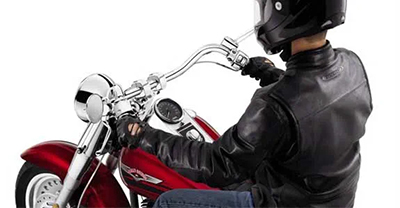The open road calls, but is your body ready to answer? For many riders, the spirit of adventure far outpaces what our bodies can handle, especially when it comes to back pain. Let's explore how to keep your passion for riding alive without sacrificing your comfort, so you can chase those endless horizons pain-free.
We love to ride. We live to ride. We know how it feels when the challenges of the world melt away under the rumbling peace of long rides down two-lane blacktops. At times, it feels like we can ride through a dozen sunsets and sunrises without stopping.
For some of us, however, our spirit of adventure is far more indomitable than our bodies will allow. We lie in bed at night dreaming of our next great ride, and in our fantasy we are supple and lithe, because in our mind, we always default to the very best version of ourselves.
And then morning comes.
Many of us have never had back problems, and we want to keep it that way. We have to take care of our bodies so they can continue to serve us for years to come. Riding for long periods of time, unfortunately, can take its toll on our lower back. Many of us know what that feels like, and many of us know how lower back pain and stiffness can dampen the exhilaration of a great ride.
WHAT CAUSES BACK PAIN WHEN RIDING A MOTORCYCLE
It’s not that riding a motorcycle is to blame. The culprit is physical stress, which, in this case, is defined as anything that your body has lost the ability to adapt to, like sitting for long periods.
Back pain is a prevalent problem in the modern world. According to the CDC, an estimated 51.6 million people in the U.S. have lower back pain at any given time1.
In addition to the physical aspects of back pain, the financial strain is also severe: More than $12 billion is spent every year to try to alleviate back pain2.
Many experts place the likelihood of any person experiencing some type of back problem throughout their lifetime at about 80 - 90 percent3.
Recently, the National Hospital Ambulatory Medical Care Survey showed that 3,050,000 people visited their doctors to deal with a case of back pain in a one-year period4.
Surveys have shown that back pain is the most common reason why people younger than age 45 don’t participate in as many activities as they would like.
In the same way that our backs have succumbed to the ravages of time by sitting at desk jobs, lifting improperly, poor posture, lack of exercise, and other bad habits can potentially contribute to back pain while sitting on a motorcycle for a length of time.
Pretending that we’re invincible and immune doesn't serve us, especially when the steps necessary to prevent back pain are so accessible and easy—and can make a trip on our motorcycle more enjoyable.
BACKGROUND
First, let’s understand why our backs start to hurt in the first place. There are only a few causes of lower back pain and almost every one of them has practical solutions.
The spine is composed of 24 movable segments called vertebrae. In between each of these segments are discs that are composed primarily of cartilage and, if they’re in good shape, should contain a significant amount of fluid, acting like a shock absorption system. These discs serve double duty as spacers, maintaining distance between the vertebrae. As such, they provide ample room for the spinal nerves to exit the spine to do their job of innervating the organs and tissues of the upper body.
If any of these segments loses its mobility or position, the joints of the spine will sacrifice their ability to adapt to wear and tear, and they begin to dysfunction. Over time they’ll degenerate, leading to a condition called a “subluxation.” The degeneration that follows is known as osteoarthritis. That means that the discs will begin to wear down or bulge. The nerves will become irritated or pinched. And all the muscles and ligaments that have worked so hard to try to maintain balance will now have to work even harder to try to prevent the whole situation from getting worse. That means tightness, spasms, and loss of flexibility.
Unfortunately, the whole process tends to be self-perpetuating. The more stress on the system, the more the system breaks down, and the more we suffer for it.
FINDING THE RIGHT FIT
“Fit” can have an enormous impact on your relationship with your motorcycle, potentially affecting your reach to properly operate the motorcycle controls which impedes confidence and general enjoyment. The tricky part is, when it’s right, you may never think about it. And when it’s wrong, you may not realize there’s a problem.
But it’s also important to know that generally all types of motorcycles can be made to fit virtually any rider. Understanding these principles and guidelines will help you find your perfect fit.
THE SYMPTOMS
Not sure if your motorcycle fits you as well as it could? Look for these five warning signs of an improper fit.
1. Overextended Reach
Reaching too far for the handlebar grips can affect your shoulders, neck, arms, and back. It can also make it tough to manipulate the throttle, braking, and steering controls to properly operate the motorcycle. This sign is readily noticed while trying to operate your motorcycle in tight spaces.
2. Backache
Lower back pain can result from an ill-fitting seat position, foot position, handlebar height, or a combination of all three.
3. Tired Hands
The handlebar grip diameter and or the brake or clutch levers adjusted too far out or too stiff for your hand size or strength can cause fatigue.
4. Knee Angle Too High
A cramped riding position puts unnecessary strain on your knees, hips, feet, and back.
5. Tiptoes
An inability to plant your feet solidly on the ground may leave you feeling a lack of control while stopped or standing over the motorcycle.
THE SOLUTIONS
The secrets to finding the right fit lie in four key areas: The seat, foot controls, handlebar, and suspension. These key areas also need to be customized/adjusted to properly fit the size, weight, and riding style position preference of the rider.
Comfortable Riding Seat
Harley-Davidson offers a variety of seat heights and shapes to accommodate virtually any size rider. Consider these factors in choosing the one that fits you best:
When seated, do your hands fall naturally on the grips/hand controls and can you fully manipulate the controls?
Do you feel comfortable putting your feet down and supporting your motorcycle when you stop? (See also “Suspension.”)
Does your back feel relaxed after hours in the saddle?
Try Before You Buy:
Ask your dealer about taking a demo seat for a spin before making this important purchase decision.
Foot Controls
Repositioning your feet on the controls can relieve muscle tension, take pressure off the tailbone, and reduce rider fatigue.
Consider your preferred riding position when determining which foot position is best for you.
Heel rests, cushioned foot pegs, and floorboard inserts help reduce foot fatigue.
Highway pegs, positioned away from the foot controls, let you stretch out your legs on longer rides.
For tall riders, extended-reach foot controls and levers reposition your feet and stretch your legs to reduce the tendency for a “knees in the air” condition.
Handlebar Position
How your motorcycle’s handlebar feels and performs is affected by three main parameters:
Rise: The vertical distance between a handlebar’s tip and its base. Bars that are too high can increase fatigue.
Pull-back: The distance the handlebar tips come back toward the rider. Greater handlebar pull-back can reduce your reach to the hand grips.
Width: Measured from tip to tip. Bars that are too wide can turn out of reach on tight turns.
Try Before You Buy:
Ask your dealer about trying different handlebar styles on an H-D™ Fit Shop motorcycle.
Suspension
After exploring seating options, lowering the suspension is often the second step in helping shorter riders reach the ground comfortably.
Rear: An H-D® Profile® Low Rear Suspension Kit can lower the motorcycle by a half-inch.
Front: A Profile Low Front Suspension Kit can take off another half-inch, to lower the seat a full inch in total.
Try Before You Buy:
H-D™ Fit Shop Slammed Suspension Simulator Mats can help you feel the difference a lowered suspension makes.
THE ERGONOMIC RIDER TRIANGLE OF COMFORT
How a motorcycle fits the rider is determined by the “triangle of comfort,” defined by the geometry of the seat/hip angle, handlebar/hands, and footpegs/feet. Suspension height and sidestand accessibility can also affect the equation.
Every Harley-Davidson® motorcycle places the rider in one of five basic riding positions:
These positions determine the triangle of comfort and can dramatically change how it feels to ride your motorcycle.
DON'T JUST SIT THERE!
The good news is, with certain precautionary measures and relatively little effort performed consistently, we can begin to restore order to the system and begin to experience a significant reduction or elimination in the amount of pain and discomfort we feel. And look forward to riding pain free.
Let’s begin with the basics.
Take frequent breaks on long rides. Every hour or so, stop and get off the motorcycle, walk around and do a couple of stretches, even for just a couple of minutes. Most important is to spend a minute or two doing extension stretches, which, in essence, reverse the effects of poor riding posture. This also gives you more opportunities to take photographs and stay hydrated.
Try to maintain proper riding position. We all know that few things in life are as aesthetically pleasing as a fellow Harley® motorcycle rider stretched out in the saddle with their feet up on the highway pegs and their hands on the bars out in front. I wouldn’t dare say to give up our classic pose. Instead, change it up. Try to ride for a while with your back erect and your feet on the boards. This is the least stressful position for your back. If you have a seat rest, this is where it serves you the most. It relieves your back muscles from having to do all the work. For example, when on a long solo trip, pack some of your gear on the seat behind you. Then, use a sleeping bag or a pack as a backrest. The difference can be extraordinary.
Try to keep your wallet in your front (or jacket) pocket while you ride. If it’s in your back pocket, you’re sitting on a wedge that rotates your entire pelvis high on that side, creating an imbalance the lower back muscles have to compensate for.
If you have a history of lower back problems, consider wearing a lumbar belt, which simply gives your back muscles some needed assistance.
Exercise consistently. If you spend 10 minutes daily doing some stretching and a few core strengtheners, you can come out way ahead. The key is to stretch the extensor muscles of the spine: the ones that bend you backward to counter the effects of slouching forward all day on the motorcycle. Because the muscles in the front and back of the legs exert a significant influence on the pelvis and the lower back, it’s very helpful to stretch them as well.
Take a walk. It’s early morning. The V-twin is still asleep, but you’re awake and the café doesn’t serve breakfast for another half hour. Go out and take that morning constitutional walk. A brisk 15- to 20-minute walk will do wonders for all aspects of your health, especially the muscles of your legs and core, which will help keep that lower back appreciative. If you’re feeling inspired, when the V-twin is parked and quiet for the night, take another 15-minute ramble. Besides, what better way to scope out the local scenery than to stroll down Main Street or take in the view from the top of a hill?
Probably the least popular suggestion is to lose the gut, that sub-sternal keg, that extra 10 or 30 pounds some of us are carrying around our waists. You know what they say, ditch the keg and get a six pack. It will take a load off your back.
We ride motorcycles for many reasons. They anchor us in a changing world, give us perspective, and allow us to spend time with our friends and loved ones. They simply are who we are. We know that our time on the road is a sacred part of our existence.
By riding safely, staying healthy, and taking care of our backs, we can continue to make memories and fill up photo albums for years to come.
Related Resources:
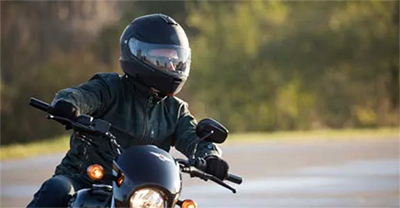
Riding is one of life's peak enjoyments, but it's not without risk. Luckily, risk can be minimized with protective gear. Stay safe and comfortable with this guide!
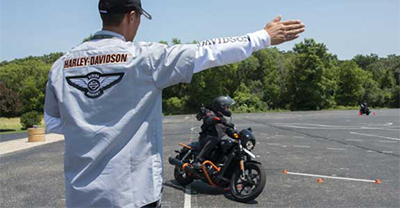
Are you a proud owner of a new motorcycle or thinking about buying one? Learning how to ride can be intimidating but incredibly rewarding. These tips will help.
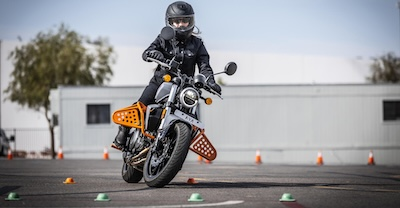
Discover why taking a motorcycle safety course is one of the best decisions you can make towards riding safely.
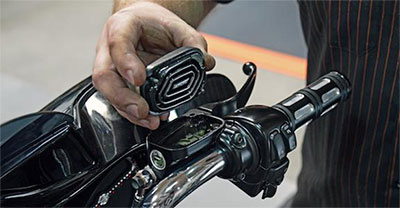
Struggling to start your motorcycle? Don't worry—we've got you covered with these essential troubleshooting tips to revive your ride and get back on the road.
[1] https://www.cdc.gov/mmwr/volumes/72/wr/mm7215a1.htm
[2]https://hpi.georgetown.edu/backpain/#:~:text=A%20leading%20cause%20of%20work,than%20adults%20without%20back%20pain.
[3] https://my.clevelandclinic.org/health/diseases/22325-back-pain
[4] https://www.cdc.gov/nchs/ahcd/index.htm
*The information in this article is presented as a service to readers of H.O.G.® magazine and does not represent any official position or medical opinions of the Harley-Davidson Motor Company.

